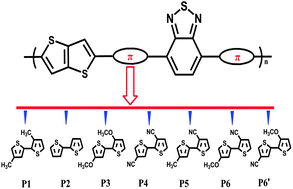Theoretical studies on the effect of a bithiophene bridge with different substituent groups (R = H, CH3, OCH3 and CN) in donor–π–acceptor copolymers for organic solar cell applications†
Abstract
An effective way to enhance the efficiency of bulk heterojunction (BHJ) solar cells is to insert suitable bridges (π) between donor units (D) and acceptor units (A) in D–π–A copolymers. This work is devoted to uncovering how the characteristics of a HT (the substituent groups via head- to-tail (HT) connection) bithiophene bridge with different substituent groups (R = H, CH3, OCH3 and CN) affect the ground state structure, electronic, optical and charge transport properties of D–π–A copolymers for improving the photovoltaic performance. Based on the D–π–A copolymer PPBzT2-CEHβ (P1) with a HT bridge of 3,4′-diethylhexyl-2,2′-bithiophene (π1), we designed six new copolymers (P2–P6′) by introducing six kinds of HT bridges. From the calculated results, the introduction of different substituent groups into the bithiophene-bridge can markedly affect the HOMO and LUMO levels, band gaps, light-absorbing efficiency and hole transport ability of the copolymers. In particular, the copolymer P6 combining the cyano and methoxyl groups into the bridge has remarkable electronic and optical properties and hole transport ability among all the copolymers P1–P6′, and it can be a candidate for donor materials of organic solar cells. We hope that the present results could provide a theoretical guidance for designing efficient donors in organic solar cells.


 Please wait while we load your content...
Please wait while we load your content...